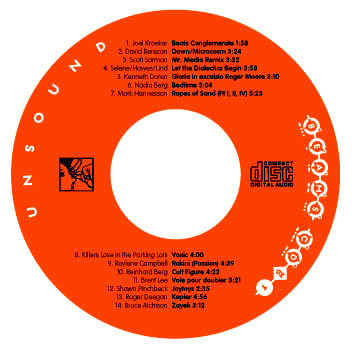Joel Kroeker: Beats
Conglomerate (1:58)
Having graduated from the University of Manitoba with
a Bachelor of
Music in Composition and Guitar Performance, Joel is currently working
towards his Masters in Ethnomusicology and Popular Music Studies at the
University of Alberta.
David Berezan: Dawn/Microcosm
(3:24)
An independent section from a larger cycle entitled
Unheard Voices,
Ancient Spaces, Dawn/Microcosm attempts to give a characteristic voice
to the mountains through combinations of environmental sound sources,
transformation, behavior and diffusion.
Scott Sarman: Mr. Media Remix
(3:32)
Created using 4-track and harmonically processed looped
television
samples to create a lush backdrop, this piece is intended to evolve
over time in a non-repeating structure.
X. I. Selene, Phil Hawes,
Jay Lind: Let the Dialectics Begin (3:58)
Our school of composition demanded the shooting and
picture editing of a 23 minute 16mm film entitled Bibliosorcery. Paul
Gelineau first
choreographed a spectacular stage fight which was filmed by a crew
of Film and Video Arts Society (FAVA) members. The actors' movements
then provided a set of constraints determining the composition to be
written. Jay Lind recorded himself in a wild improvisation session,
which wasthen sampled by P. Granville Hawes. X. and P. manipulated
the samples on ProTools to correspond to the picture cut. This is the
first composition
of the Optical Sound Movement. Mixed by Mike Boroditsky.
Kenneth Doren: Gloria in excelsio
Roger Moore (3:10)
Kenneth Doren is a multi-media artist whose art installations,
videos
and audio compositions have been presented nationally and
internationally. Gloria in excelsio Roger Moore is one of the 18
movements from Kennethís digital opera Allegro Molto Con Brio
King Kong. Kennethís web site is www.digitalopera.org
Nadia Berg: Bedtime (5:04)
Nadia Berg was 12 when she created Bedtime, for which
Dr. Howard Bashaw awarded her first place in the 1998 Kiwanis music
competition. She used two Casio CT 470 and one Roland U-20 synthesizers,
all mixes and cross-fades were done in real time on the three keyboards.
Mark Hannesson: Ropes of Sand
(Pt I, II, IV) (5:23)
Composed between September 1999 and January 2000, Ropes
of Sand uses as its single sound source a sample of the composer's
voice that was processed using various sound manipulation programs
on both Mac and PC.
Killers Lose in the Parking
Lots: Voxic (4:00)
Like Hannesson's Ropes of Sand, processed human voice
is the sole sound source for this piece. Voxic manifests a certain
irony in the repetitive mantra that disparages itself.
Raylene Campbell: Rakini (Passion)
(4:39)
Raylene Campbell is an accordionist and electro-acoustic
composer from Edmonton. She is currently studying DeepListening with
Pauline
Oliveros, and creating a computer interactive performance art show
which she will tour by the year 2002. Rakini (Passion) is the second
section of a piece that Raylene composed in collaboration with
choreographer/dancer Tania Alvarado.
Reinhard Berg: Cult Figure
(4:22)
Cult Figure was created for dancer Marian Sarach in
l988 using voice, the inside of a grand piano, tambour plus resined
baton, and
reconstructed violin. The dance was performed in Edmonton and Calgary
that year.
Brent Lee: Voie pour doubler (3:21)
Brent Lee is a graduate of McGill University and the
University of
British Columbia. His work ranges from orchestral music to
electroacoustic pieces, and includes jazz compositions and incidental
music. He is currently a researcher on the InterPARES Project, which
aims to develop strategies for the long-term preservation of digital
documents. He has been an associate composer of the Canadian Music
Centre since 1991.
Shawn Pinchbeck: Joytoys
(2:35)
Joytoys is an algorhythmically generated conversation
where textual
elements recombine into new contexts throughout the piece. The original
text was selected and read by Chenoa Anderson and Shawn via chance
operations. This piece was composed to represent Shawn at a birthday
party in 1995, where each party attendee was asked to record their
party conversation in advance.
Roger Deegan: Kepler (4:56)
Johannes Kepler (1571-1630) believed that the six known
planets were identifiable by the unique tones they generated. The piece
begins with sounds representing space, dust, and asteroids; musical
motives of each planet are then introduced, one by one, beginning with
Mercury and ending with Saturn.
Bruce Atchison: Zayek (3:12)
Since his humble beginnings in 1984, Bruce has become
a mainstay in the Edmonton experimental music scene. His compositions
have been played around the world, from Moscow to Portland.
|

